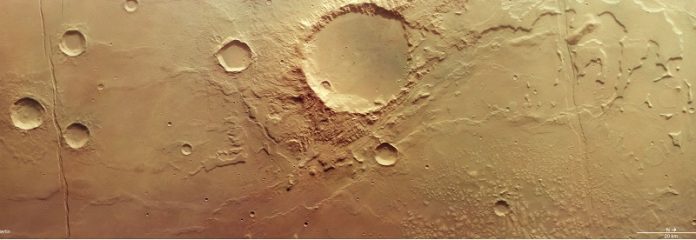
The ESA’s Mars Express orbiter captured an image of the remains of a vast ancient lake on Mars.
The remnant lake bed has been weathered and altered by the passing of billions of years.
In the planet’s distant past, scientists say, it held enough water to fill Earth’s Caspian Sea almost three times over.
The leading image shows a region on Mars called Caralis Chaos.
At first glance, it just looks like a vague outline of a depression scrambled and scarred by time, with Mars’ ubiquitous impact craters sprinkled throughout the image.
But for scientists who study planetary surface features, the image is rife with clues—clues that connect it to Mars’ warm and watery ancient past and to the ensuing episodes of change the planet underwent.
The following topographical map brings clarity.
The ancient lakebed consists of several basins surrounding and including the Caralis Chaos region.
In the distant past, they were all joined into one big lake named Lake Eridania. It had a surface area of about 1.1 million square km. The largest non-ocean body of water on Earth is the Caspian Sea, with a surface area of 389,000 km.
Liquid water was likely abundant on early Mars between about 4.1 and 3 billion years ago during the Noachian and Hesperian Periods. Mars may have even hosted a massive ocean that covered about one-third of its surface. Eridania Lake was likely a single lake until the late Noachian when Mars gradually lost its water. During that period, the lake was fragmented into multiple smaller lakes.
The ancient lakebed is now punctuated with mounds. Scientists think Mars’ dusty winds initially formed the mounds. Later, they were covered by water, then the water disappeared, and they were exposed to the wind again.
The floors of all of the basins that comprised Eridania Lake are covered by light-toned materials containing Fe/Mg-phyllosilicates. The region also has chloride, indicating that a playa region once existed here as the water receded. Some of the geological evidence in the region suggests that some surface water may have survived until long after the Noachian.
There’s also evidence of volcanic activity. Two large faults called fossae run through the region. Collectively, they’re known as Sirenum Fossae.
The region between the two faults is called a graben, a depressed portion of the crust. Sirenum Fossae was formed as Mars’ Tharsis region, a vast volcanic plateau that’s home to Olympus Mons and Tharsis Montes, rose up and put enormous pressure on the crust.
These images all come from the ESA’s Mars Express Orbiter. It has been orbiting Mars since 2004, mapping its surface and minerals and studying the planet’s interior, subsurface, and atmosphere. It has been in orbit for more than 20 years.
The ESA has extended its mission until at least the end of 2026 and has given it a provisional extension until 2028.
Written by Evan Gough/Universe Today.



